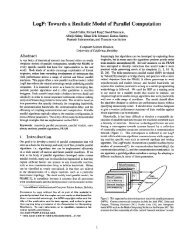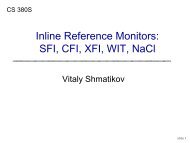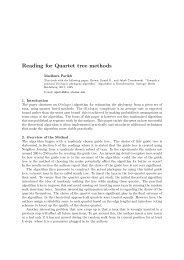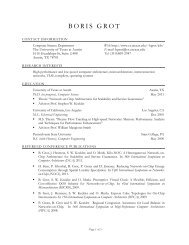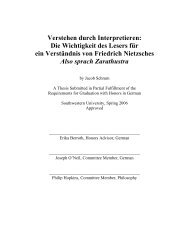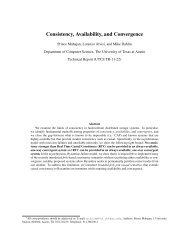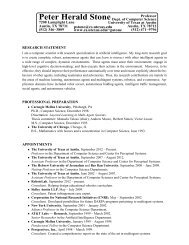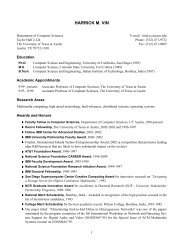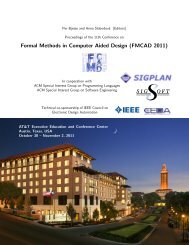A User's Guide to gringo, clasp, clingo, and iclingo
A User's Guide to gringo, clasp, clingo, and iclingo
A User's Guide to gringo, clasp, clingo, and iclingo
You also want an ePaper? Increase the reach of your titles
YUMPU automatically turns print PDFs into web optimized ePapers that Google loves.
2<br />
3<br />
3<br />
1<br />
3<br />
2<br />
6<br />
2<br />
1 2<br />
4<br />
Figure 5: The Graph from Figure 3 along with Edge Costs.<br />
Answer: 1<br />
... color(1,2) color(2,1) color(3,1) \<br />
color(4,3) color(5,2) color(6,3)<br />
Note that we have omitted the six instances of node/1 <strong>and</strong> the 17 instances of edge/2<br />
in order <strong>to</strong> emphasize the actual solution, which is depicted in Figure 4. Such output<br />
projection can also be specified within a logic program file by using the declaratives<br />
#hide <strong>and</strong> #show, described in Section 3.1.12.<br />
4.2 Traveling Salesperson<br />
We now consider the well-known Traveling Salesperson Problem (TSP), where the task<br />
is <strong>to</strong> decide whether there is a round trip that visits each node in a graph exactly once<br />
(viz., a Hamil<strong>to</strong>nian cycle) <strong>and</strong> whose accumulated edge costs must not exceed some<br />
budget B. We tackle a slightly more general variant of the problem by not a priori<br />
fixing B <strong>to</strong> any integer. Rather, we want <strong>to</strong> compute a minimum budget B along with<br />
a round trip of cost B. This problem is FP NP -complete (cf. [44]), that is, it can be<br />
solved with a polynomial number of queries <strong>to</strong> an NP-oracle. As with N-Coloring, we<br />
provide a uniform problem definition by separating the encoding from instances.<br />
4.2.1 Problem Instance<br />
We reuse graph specifications in terms of predicates node/1 <strong>and</strong> edge/2 as in Section<br />
4.1.1. In addition, facts over predicate cost/3 are used <strong>to</strong> define edge costs:<br />
1 % Edge Costs<br />
2 cost(1,2,2). cost(1,3,3). cost(1,4,1).<br />
3 cost(2,4,2). cost(2,5,2). cost(2,6,4).<br />
4 cost(3,1,3). cost(3,4,2). cost(3,5,2).<br />
5 cost(4,1,1). cost(4,2,2).<br />
6 cost(5,3,2). cost(5,4,2). cost(5,6,1).<br />
7 cost(6,2,4). cost(6,3,3). cost(6,5,1).<br />
Figure 5 shows the (directed) graph from Figure 3 along with the associated edge costs.<br />
Symmetric edges have the same costs here, but differing costs would also be possible.<br />
34<br />
1<br />
4<br />
5<br />
2<br />
2<br />
2



